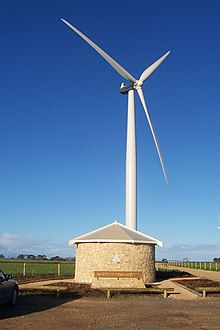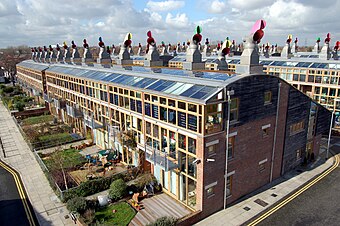
Back بوابة:طاقة متجددة Arabic Portail:Énergie renouvelable French Portal:Tenaga boleh diperbaharui Malay Portal:可再生能源 Chinese
Introduction Renewable energy (or green energy) is energy from renewable natural resources that are replenished on a human timescale. The most widely used renewable energy types are solar energy, wind power and hydropower. Bioenergy and geothermal power are also significant in some countries. Some also consider nuclear power a renewable power source, although this is controversial. Renewable energy installations can be large or small and are suited for both urban and rural areas. Renewable energy is often deployed together with further electrification. This has several benefits: electricity can move heat and vehicles efficiently, and is clean at the point of consumption. Variable renewable energy sources are those that have a fluctuating nature, such as wind power and solar power. In contrast, controllable renewable energy sources include dammed hydroelectricity, bioenergy, or geothermal power. Renewable energy systems have rapidly become more efficient and cheaper over the past 30 years. A large majority of worldwide newly installed electricity capacity is now renewable. Renewable energy sources, such as solar and wind power, have seen significant cost reductions over the past decade, making them more competitive with traditional fossil fuels. In most countries, photovoltaic solar or onshore wind are the cheapest new-build electricity. From 2011 to 2021, renewable energy grew from 20% to 28% of global electricity supply. Power from sun and wind accounted for most of this increase, growing from a combined 2% to 10%. Use of fossil energy shrank from 68% to 62%. In 2022, renewables accounted for 30% of global electricity generation, and are projected to reach over 42% by 2028. Many countries already have renewables contributing more than 20% of their total energy supply, with some generating over half or even all their electricity from renewable sources. The main motivation to replace fossil fuels with renewable energy sources is to slow and eventually stop climate change, which is widely agreed to be caused mostly by greenhouse gas emissions. In general, renewable energy sources cause much lower emissions than fossil fuels. The International Energy Agency estimates that to achieve net zero emissions by 2050, 90% of global electricity generation will need to be produced from renewable sources. Renewables also cause much less air pollution than fossil fuels, improving public health, and are less noisy. The deployment of renewable energy still faces obstacles, especially fossil fuel subsidies, lobbying by incumbent power providers, and local opposition to the use of land for renewables installations. Like all mining, the extraction of minerals required for many renewable energy technologies also results in environmental damage. In addition, although most renewable energy sources are sustainable, some are not. For example, some biomass sources are unsustainable at current rates of exploitation. (Full article...) Selected article - Wind power became a significant energy source within South Australia over the first two decades of the 21st century. In 2015, there was an installed capacity of 1,475 MW, which accounted for 34% of electricity production in the state. This accounted for 35% of Australia's installed wind power capacity. In 2021, there was an installed capacity of 2052.95 MW, which accounted for 42.1% of the electricity production in the state in 2020. The development of wind power capacity in South Australia has been encouraged by a number of factors. These include the Australian Government's Renewable Energy Target, which require electricity retailers to source a proportion of energy from renewable sources, incentives from the South Australian Government including a supportive regulatory regime and a payroll tax rebate scheme for large scale renewable energy developments. Also the state's proximity to the Roaring forties means there are high quality wind resources for wind farms to exploit. In mid-2009, RenewablesSA was established by the South Australian Government to encourage further investment in renewable energy in the state. The load factor (or capacity factor) for South Australian wind farms is usually in the range of 32-38%. This means that a wind farm could typically produce between 32 and 38% of its nameplate capacity averaged over a year. (Full article...)Quotations -
– Christopher Flavin in Worldwatch Institute (2008). Building a Low-Carbon Economy in State of the World 2008, p. 80. Main topicsRenewable energy sourcesGeneralRenewable energy commercialization · Smart grid · Timeline of sustainable energy research 2020–present Renewable energy by countryList of countries by electricity production from renewable sources
WikiProjectsWikiProjects connected with renewable energy: Selected image -
The BedZED housing development in London was designed to use only energy from renewable sources generated on site. Selected biography -Elon Reeve Musk (/ˈiːlɒn/; born June 28, 1971) is a businessman and investor known for his key roles in space company SpaceX and automotive company Tesla, Inc. Other involvements include ownership of X Corp., formerly Twitter, and his role in the founding of The Boring Company, xAI, Neuralink and OpenAI. He is one of the wealthiest people in the world; , Forbes estimates his net worth to be US$214 billion. Musk was born in Pretoria to Maye and Errol Musk and briefly attended the University of Pretoria before immigrating to Canada at age 18, acquiring citizenship through his Canadian-born mother. Two years later, he matriculated at Queen's University at Kingston in Canada. Musk later transferred to the University of Pennsylvania and received bachelor's degrees in economics and physics. He moved to California in 1995 to attend Stanford University, but dropped out after two days and, with his brother Kimbal, co-founded online city guide software company Zip2. The startup was acquired by Compaq for $307 million in 1999. That same year, Musk co-founded X.com, a direct bank. X.com merged with Confinity in 2000 to form PayPal. In October 2002, eBay acquired PayPal for $1.5 billion. Using $100 million of the money he made from the sale of PayPal, Musk founded SpaceX, a spaceflight services company, in 2002. (Full article...)Did you know? -... that Selling Solar: The Diffusion of Renewable Energy in Emerging Markets, a 2009 Earthscan book by Damian Miller, argues that in order to solve the climate crisis, the world must immediately and dramatically accelerate the commercialization of renewable energy technology ? This needs to happen in the industrialized world, as well as in the emerging markets of the developing world where most future GHG emissions will occur. General images -The following are images from various renewable energy-related articles on Wikipedia.
Related portalsCategoriesAssociated WikimediaThe following Wikimedia Foundation sister projects provide more on this subject:
Discover Wikipedia using portals |
© MMXXIII Rich X Search. We shall prevail. All rights reserved. Rich X Search



















![Image 16Concentrated solar panels are getting a power boost. Pacific Northwest National Laboratory (PNNL) will be testing a new concentrated solar power system – one that can help natural gas power plants reduce their fuel usage by up to 20 percent.[needs update] (from Solar energy)](http://upload.wikimedia.org/wikipedia/commons/thumb/8/82/Photo_of_the_Week-_Boosting_Solar_Technology_%288722948189%29.jpg/120px-Photo_of_the_Week-_Boosting_Solar_Technology_%288722948189%29.jpg)




























































